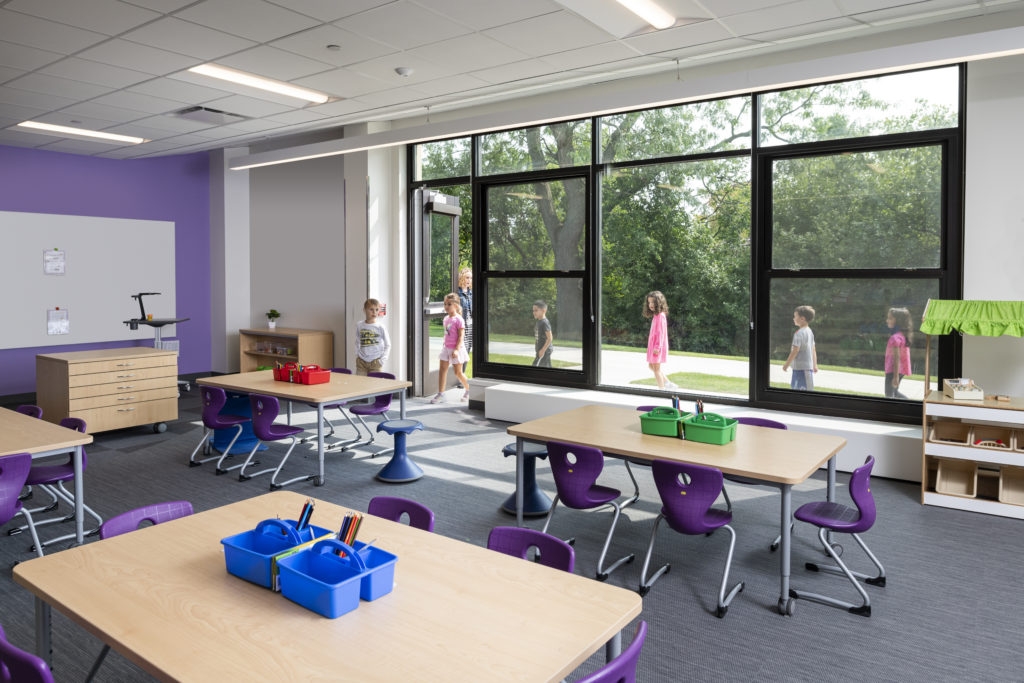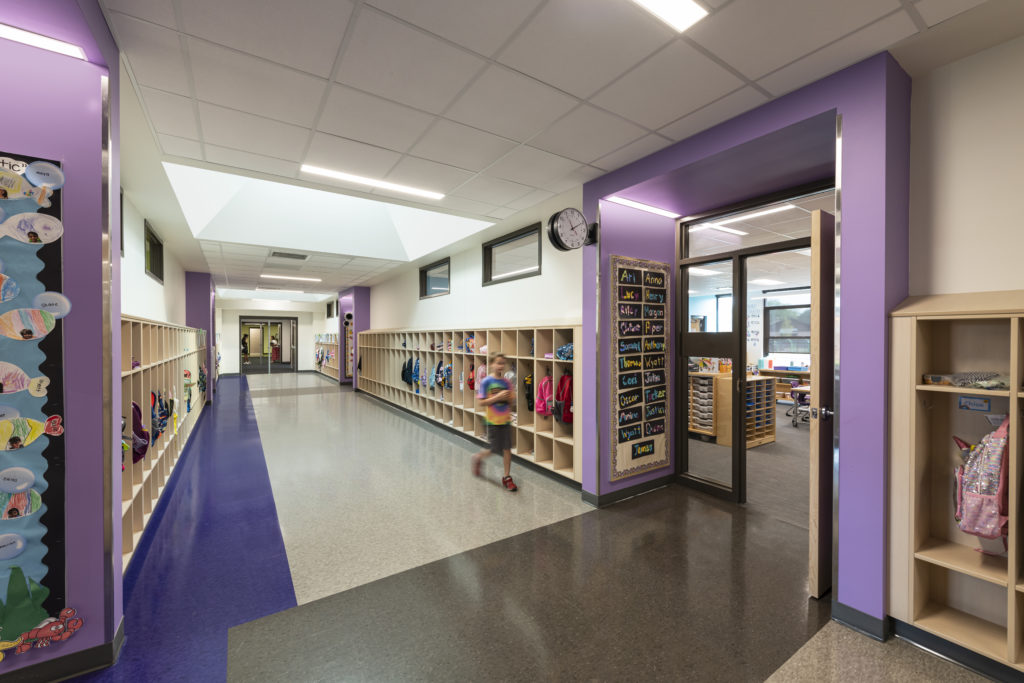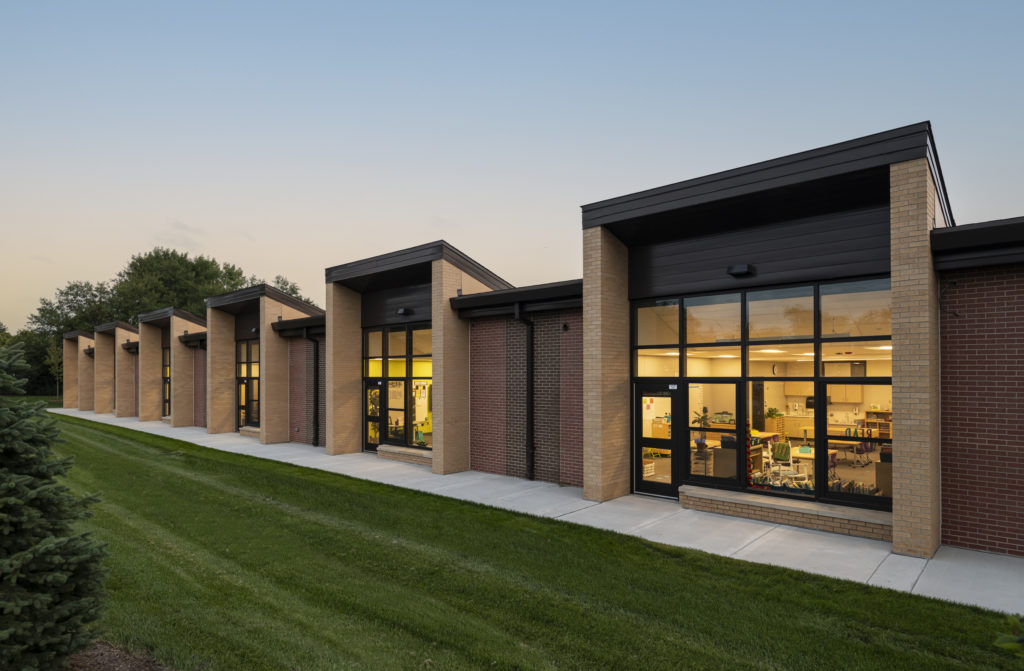Glenview SD 34 is transforming the learning spaces in its eight elementary schools to support student-centered learning. Teachers are an essential voice in this process. This is the story of District 34’s journey.
How It Began
In March 2020, voters in Glenview, IL, approved a $119 million capital referendum that launched Building Future, a multi-year initiative to expand and renovate Glenview School District 34’s eight schools. District 34, located in Chicago’s northern suburbs, serves approximately 4,300 PK-Grade 8 students in three primary schools (PK-Grade 2), three intermediate schools (Grades 3-5) and two middle schools (Grades 6-8).
While the successful referendum was a pivotal moment, the journey to transform District 34’s learning spaces began in 2013, when the Glenview Education Foundation (GEF) made an initial $15,000 grant that district leaders used to begin exploring how new kinds of learning spaces could impact students’ educational experience. The outcome of this early investment, a comprehensively renovated library media center in one primary school, became a must-visit learning space for educators throughout District 34.
Energized by this experience, in 2018, District 34 leaders launched a strategic process to identify, prioritize and win support for a substantial community investment to transform the learning environment in all its schools. FGM Architects (FGMA) was chosen to lead a facilities assessment to determine infrastructure needs and a space utilization study to identify space needs and learning environment deficiencies.

FGMA developed 90+ design concepts that were honed into a Facilities Master Plan which was the foundation of the successful referendum. At every stage of the process, FGMA and district leaders engaged administrators, teachers, staff, students, and community members to elicit their input.
Building Future incorporates three core strategies to remake District 34’s learning spaces:
- District-wide classroom renovations.
- Additions and renovations at three primary schools to make room for all-day kindergarten.
- Expansion and renovation of one middle school.
Engaging Teachers
District 34 leaders knew that engaged teachers were the key to achieving the best results from district-wide classroom renovations. In partnership with FGMA, and with continued support from the GEF totaling $450,000, a pilot design initiative took shape. A peer-selected learning space committee was formed with teachers from each grade level and school as well as principals and district personnel. FGMA led the committee through a participatory process that resulted in unique design concepts that were pilot tested in one classroom at each school.
The design team developed concepts for each school to support the new student-centered pedagogy. The design concepts were based on innovative approaches to teaching and learning such as providing flexible learning space, encouraging collaboration, and supporting hands-on curriculum. Throughout the process, committee members shared discussion highlights with colleagues at their respective schools resulting in an interactive feedback loop.
By testing design concepts in actual classrooms, students and teachers demonstrated how the learning experience was impacted by new approaches to space, furniture and materials.
The design concepts assessed at each school embodied an approach to a three-dimensional, flexible environment that would enhance the learning experience with distinct zones for different activities as well as individual and group engagement. Each pilot was staged with diverse types of lighting, flooring, finishes and flexible furniture that included seating, work surfaces and storage. The design elements deemed successful were then incorporated into the next round of design testing at another school.
District 34’s re-imagined learning environments also includes new approaches to classroom storage which emphasizes shared storage to maximize space and promote shared resources. This approach also aligns with the guiding principles of adaptive, functional spaces that support seamless transitions between activities and easy access to classroom resources. Each school now has centralized storage space for grade-specific resources, which reinforces the district’s commitment to its curriculum.
FGMA’s role in this process was to integrate teacher feedback with best-practice research to create an optimal design for scaling up renovated classroom spaces. The district adjusted based on teacher feedback to create a comprehensive program to best support curriculum, instruction and student engagement.

By testing design concepts in actual classrooms, students and teachers demonstrated how the learning experience was impacted by new approaches to space, furniture and materials. In addition, teachers had the opportunity to test new ways of teaching and managing the classroom environment.
Throughout the process, pilot teachers connected and supported one another through an internal online forum in which they posted insights, questions and observations about their experiences with the new classroom environments. This forum is now an archive documenting collaborative problem-solving and solutions. It also serves as a tool to reflect on discussions that connected the new learning environments to student success initiatives within the pilot.
Thanks to the collaborative, collegial, team-based culture of District 34, lessons from the pilot classrooms filtered into other classrooms. Observing what was happening in the pilot classrooms, other teachers began to modify their own spaces – and their instruction – to be more flexible, creative, and student-led.

The pilot design process effectively created the conditions for consensus-building and buy-in from teachers, who are key to the core success of the Building Future initiative which strengthened teaching and learning. By engaging teachers as active participants, District 34 empowered their ownership of the learning environment. An ongoing benefit of engaging teachers in an inquiry-based design process is that they have learned more about how to use this process with their students.
Moreover, lessons from the inquiry-based, collaborative process helped district leaders share a powerful story with the community that contributed to the referendum’s success. When Building Future launched, District 34 had a wealth of experience that fueled the effective expansion of renovating learning spaces district wide.
A Continuing Journey
To be dynamic, learning environments must constantly evolve. And teachers still have a lot to say and ask about their new environments for teaching and learning!
Going forward, the district has incorporated professional development about the importance of the learning environment into its systems for professional learning. Teachers are provided support through coaching, collaborative team meetings, classroom observation, co-teaching opportunities, and other professional development activities. The district’s Instructional Innovation Specialists are rolling out a program and toolkit for teachers and students to make the most of their new learning environments.
The pilot design project that launched Building Future, a district-wide reimagining of learning environments, was the spark to realize District 34’s innovative vision for learning success which prioritizes spaces that provide the spark for curiosity, connection, collaboration and creativity. When Building Future is complete in 2024, District 34 will have over 240 new and renovated learning spaces in which students are the beneficiaries of a vision that their teachers have helped realize.

